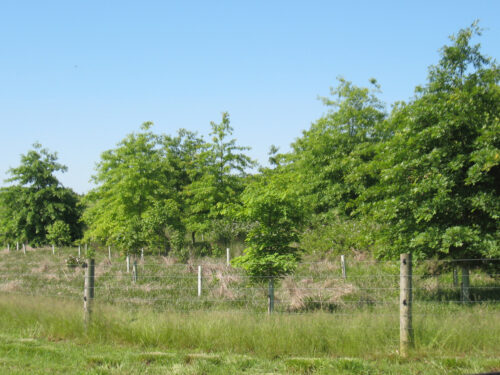
Trees and Shrubs to Protect Water Quality
There are natural and human-caused activities that affect water quality and availability, including extreme weather events, wildfires, and changes in land use. Clearing forests and developing land for residential, commercial, or industrial uses can negatively influence water quality. One effective tool for helping to slow the speed of and filter pollutants out of the water is to establish healthy riparian forest buffer zones along streams and other waterbodies.
Riparian Forest Buffer: a linear wooded area of varying width near a water feature that helps to filter nutrients, sediments, and other pollutants from runoff, as well as removes nutrients from groundwater. Riparian refers to water features, so riparian forest buffers are transition areas that protect streams, creeks, or other water bodies from pollutants.
Riparian forest buffer zones contain many trees and other vegetation, which slow and absorb floodwaters. This reduces the likelihood of floodwaters reaching downstream areas that may be heavily populated and developed. When streams or rivers overflow their banks due to flooding, riparian zones slow these waters, causing them to drop much of the sediments and nutrients they were carrying in suspension. Trees and other vegetation trap and absorb the sediment, promoting further growth and increasing the density of root systems.
Stream or riverbeds and the soil of riparian forest buffers play an important role in the storage and filtering of groundwater. During spring thaws and other periods of flooding, they absorb water through many different cracks and pores quite readily, storing it as groundwater, allowing it to slowly percolate back into our water supply.
Riparian buffers also provide important wildlife habitat along waterways. The dense networks formed by trees and other plants in riparian buffers provide excellent shade to cool water temperatures.
Planting Forest Buffers
 Establishing new riparian buffers on open land where they don’t currently exist, or expanding existing buffers provide many benefits described previously. Riparian forest buffer species include trees and shrubs adapted to tolerate periodic flooding and saturated soils.
Establishing new riparian buffers on open land where they don’t currently exist, or expanding existing buffers provide many benefits described previously. Riparian forest buffer species include trees and shrubs adapted to tolerate periodic flooding and saturated soils.
VDOF Seedling Nurseries grow riparian tree species for sale in our seedling store.
VDOF can provide assistance to landowners in planning how best to establish a buffer. Steps often include getting the land ready (preparation), planting trees or ensuring natural seeding of new trees, and follow-up.
Read more about riparian forest buffers in urban areas.
Get help with planting riparian forest buffers.
A variety of financial assistance programs are available through VDOF and partner agencies for forest management activities to help protect water quality.
Explore All Financial Assistance Programs
Additional Resources
[posts_table columns="image,title:Title,cf:id_number:ID,content:Description,tax:Media,button" post_type="document-library" rows_per_page="5" exclude_term="Audiences:no, Media:news-releases" term="document-tags:riparian-forest-buffers" filters="tax:document-category:Select Category,tax:Media:Select Content Type" search_box="true" reset_button="true"]Contact Us
Your local VDOF forester can provide guidance with planting riparian forest buffers. Contact your local VDOF forester.
For more information or questions, e-mail us or use our contact form.
